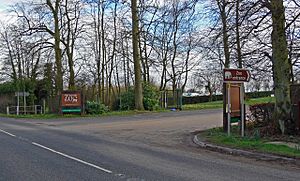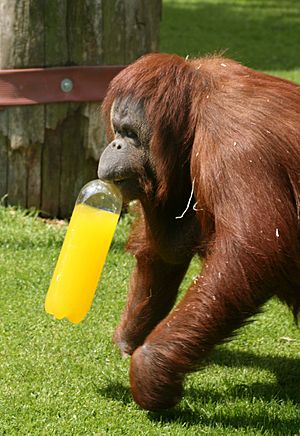Twycross Zoo facts for kids

The zoo entrance, on the A444
|
|
| Date opened | 1963 |
|---|---|
| Location | Norton Grange, Norton Juxta Twycross, Leicestershire, England |
| Land area | 80 acres (32 ha) |
| Coordinates | 52°39′10″N 1°31′47″W / 52.65278°N 1.52972°W |
| No. of animals | 900+ |
| No. of species | 150+ |
| Memberships | BIAZA, EAZA, WAZA |
| Major exhibits | Great apes, monkeys, Amur leopards, snow leopards, Bornean Longhouse |
Twycross Zoo is a large zoo located near Norton Juxta Twycross in Leicestershire, England. It is famous for having one of the biggest collections of monkeys and apes in the Western world. In 2006, the zoo was even renamed "Twycross Zoo – The World Primate Centre" to highlight this special focus.
In 2019, over 644,000 people visited Twycross Zoo. It's a great place to learn about animals and their habitats.
Contents
History of Twycross Zoo
Twycross Zoo was started in 1963 by two friends, Molly Badham and Nathalie Evans. They had a smaller zoo called Hints Zoological Gardens. They needed more space for their growing animal collection.
They found the perfect spot at a former rectory, or church house, called Norton Grange. Molly and Nathalie turned the 12 acres of gardens and farm buildings into a zoo.
The zoo first opened its doors on May 26, 1963. A local TV star, Jean Morton, helped open it with her puppet characters, Tingha and Tucker.
In 1972, the zoo became a charity. It became known for its amazing collection of primates. This includes all four types of great apes. Twycross Zoo is the only place in the UK where you can see bonobos.
The zoo has been very successful at breeding primates. They have had the first UK births for 13 different species. This includes bonobos, siamangs, and woolly monkeys. These efforts help with important conservation programs.
In 2000, Molly Badham and Nathalie Evans wrote a book. It was called Molly's Zoo and told the story of how the zoo began.
Molly Badham's Work
Molly Badham was an expert in caring for primates. She was especially known for her work with chimpanzees. Molly achieved many amazing things during her time leading the zoo. She was also a founder of the National Federation of Zoological Gardens of Great Britain and Ireland.
In the past, some zoos used animals in ways we now know aren't best for them. For example, some of Twycross Zoo's chimpanzees appeared in TV commercials and films. Today, Twycross Zoo focuses on letting animals live as naturally as possible.
Exploring the Animal Exhibits
Twycross Zoo is home to about 500 animals from nearly 150 species. Many of these species are endangered. The zoo is famous for its primates. It is the only zoo in the UK to have all four types of great apes. These are gorillas, orangutans, chimpanzees, and bonobos. The bonobos at Twycross are the only ones in the country.
Currently, the zoo has four orangutans, five gorillas, 20 chimpanzees, and 13 bonobos. Twycross Zoo also has one of the largest collections of gibbons in Europe. A large part of their animal collection is considered threatened by the IUCN. Many animals at the zoo are part of breeding programs. These programs help protect species from extinction.
The animal exhibits at Twycross Zoo are divided into eight special zones.
Conservation Way
Conservation Way is where you can find a family of critically endangered Amur leopards. These are the rarest big cats in the world. In 2014, female Kristen had two cubs, Arina and Alexei. This was part of a special breeding program.
You can also see endangered siamang gibbons here. The 'African Plains' exhibit is also in this zone. It is home to a group of Chapman's zebras.
Meerkats live here too. Their home was made bigger in 2013. It now has a tall artificial termite mound. The meerkats love to stand on it and act as lookouts. Low windows let younger visitors get a great view.
Wet and Wild
This zone features Humboldt penguins, cranes, and flamingos. It also has the Borneo Longhouse aviary. This walkthrough exhibit opened in 2007. It looks like a traditional longhouse. Visitors can walk inside and see birds in a natural setting. This helps people understand the importance of wetland habitats.
Other animals in Wet and Wild include tapirs, capybaras, and bush dogs. You can also find three types of owls here. Look for two-toed sloths, tortoises, and bat-eared foxes. This zone is also home to howler monkeys, colobus monkeys, and Eastern Black Rhinoceros. A new Sumatran Tiger also lives here.
Kingdom of the Apes
Twycross Zoo is the only zoo in the UK with all four types of great apes. Kingdom of the Apes is home to three of them: bonobos, chimpanzees, and gorillas.
The "Walking with Lemurs" exhibit is also here. It's a walkthrough area where you can enter the home of ring-tailed and black-and-white ruffed lemurs. You can learn about threats to their home in Madagascar. You also get to see these energetic animals up close.
This zone also has Aldabra giant tortoises. These are some of the biggest tortoises in the world. Their enclosure was made larger in 2013. It now has more space and different types of ground. A bathing pool was added for hot days.
Kingdom of the Apes also houses dholes, tufted deer, and Nyala. You can find more lemur species here too, like crowned lemurs.
Life in the Trees

Life in the Trees shows many different types of monkeys. These include black-headed spider monkeys, red-faced spider monkeys, and De Brazza's monkeys. You can also see spectacled langurs and L'Hoest's monkeys.
Twycross Zoo has one of the largest collections of gibbons in Europe. These small apes live in the new Gibbon Forest. There are four different species of gibbon here. These include siamangs, white-cheeked gibbons, and agile gibbons.
This zone is also home to orangutans. In 2014, a special termite mound was built in their enclosure. It's used for enrichment, meaning it gives the orangutans something fun to do. They can use tools to get treats from the holes.
You can also find otters and parrots in this zone.
Explorer Zone
The Explorer Zone was updated and made bigger in 2014. It now has a new adventure playground, a gift shop, and places to eat. It also features a Butterfly Forest.
The Butterfly Forest is a large walkthrough exhibit. It was designed by the zoo staff. Visitors walk along a path through lots of plants. They can see hundreds of different butterflies. You can also watch their life cycle, from chrysalis to butterfly. Victoria Crowned Pigeons also live inside.
In 2014, some insects moved into the Butterfly Forest. These included giant millipedes and stick insects.
The Explorer Zone also has Pets@Twycross. Here you can see domestic animals. These include West African pygmy goats, alpacas, and miniature donkeys. You can also find rats, ferrets, and guinea pigs. There are also rabbits and rare Leicester Longwool sheep. Some reptiles, like corn snakes and tortoises, are here too.
Himalaya
The Himalaya Visitor Centre opened in 2010. It is the main entrance to the zoo and is free to enter. Inside, you'll find the zoo's main gift shop and a large restaurant. The restaurant looks out onto a Himalayan mountain scene. This is the home of a family of endangered snow leopards.
Twycross Zoo also has conference rooms here. The Windows on the Wild room can hold 100 people. It overlooks a wild habitat with wallabies and muntjac deer.
Nature Reserve
Twycross Zoo has its own Nature Reserve. It is also free to enter. This large area provides a safe home for local bats, birds, insects, and small mammals.
Education at the Zoo
Twycross Zoo has an amazing education department. It has won awards for its work. The zoo teaches over 15,000 school children each year. They use four special classrooms. Each room has a different theme, like the rainforest or the illegal wildlife trade. All lessons are linked to school subjects. They are designed to be fun for all ages.
Conservation and Breeding Efforts
In 2006, Twycross Zoo started the Conservation Welfare Fund. This fund helps protect animals and improve their welfare around the world.
Since it began, the fund has supported over 55 projects. These projects are in 27 different countries. Twycross Zoo provides money and also shares its knowledge. This includes animal care, vet care, and building enclosures.
Twycross Zoo supports many important conservation projects. Some examples include:
- Helping Fauna and Flora International with their Cao Vit Gibbon Project.
- Supporting Ape Action Africa and their ape sanctuary in Cameroon.
- Working with Wildlife Vets International to help Amur leopards in Russia.
- Supporting Friends of Bonobos and the only bonobo sanctuary in the world.
- Helping AEECL with research and conservation for lemurs in Madagascar.
- Working with Awely to educate communities in the Congo about bonobos.
In 2014, Twycross Zoo teamed up with the United Nations Great Ape Survival Partnership. Their goal is to help great apes and their homes survive in Africa and Asia.
Twycross Zoo is a member of several important organizations. These include BIAZA, EAZA, and WAZA. These groups help zoos work together globally. Zoo staff also help lead and advise on many international zoo committees.
In June 2014, two critically endangered Amur leopard cubs were born at the zoo. Their father, Davidoff, was also born at Twycross in 2006. In October 2014, a baby vicuña was born. Vicuñas are part of the camel family.


